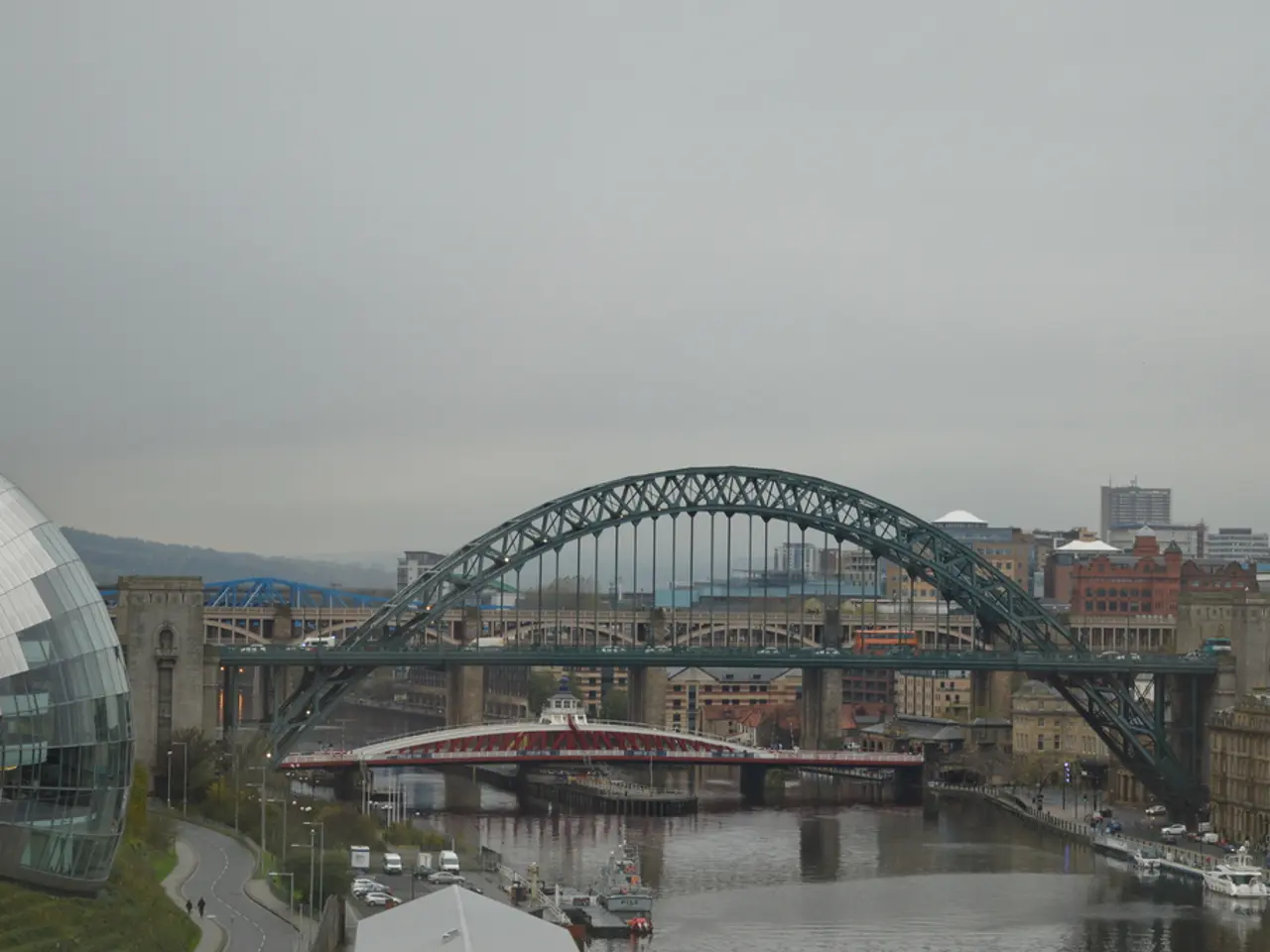Heavy Rain Causes Flash Floods in Hyderabad: Severe Waterlogging Affects City Living during Heavy Rainfall
On the 7th of August, 2025, Hyderabad experienced a devastating flash flood due to heavy rainfall, causing extensive waterlogging and traffic chaos. This event, known as the Hyderabad heavy rain flash floods, has underscored the city's vulnerability to extreme weather events and the need for adaptive urban planning and enhanced disaster preparedness.
The causes of the Hyderabad heavy rain flash floods can be traced back to unregulated urban development, leading to blocked and inadequate drainage systems. Rapid urbanization, encroachment on natural drainage paths, and the destruction or neglect of natural water bodies such as lakes and stormwater drains (nalas) have contributed to the flooding risks.
The effects of these floods have been widespread, leading to waterlogging, damage to property, disruption of traffic, and a threat to public safety. Low-lying areas, like those in Ameerpet, experience recurring inundation during monsoons, necessitating urgent flood mitigation actions.
To improve urban flood management and resilience, the government and municipal authorities have planned multiple strategic interventions. These include the development of an Integrated Stormwater Drainage Network, the creation of a Comprehensive Stormwater Master Plan, flood mitigation measures in low-lying areas, lake restoration and nala widening, preventing encroachments and drain blockage, and long-term urban water management incorporation.
The Integrated Stormwater Drainage Network aims to interlink all lakes, nalas, and stormwater drains to channel rainwater systematically into the Musi River, which is undergoing rejuvenation as a permanent flood management solution. A Comprehensive Stormwater Master Plan has been approved to survey and map drainage and flood-prone areas using GIS and hydrological modeling, aimed at identifying critical drainage improvements, minimizing flood damage, and prioritizing infrastructure investments.
GHMC is conducting detailed surveys of rainfall intensity and drainage discharge to design effective stormwater drain networks in flood-prone localities like Ameerpet, employing the latest national and international techniques. Focused efforts are being made on restoring lakes and widening nalas to enhance water holding and conveyance capacities during heavy rainfall.
Preventing encroachments and drain blockage is another key focus area, with efforts directed at addressing issues like plastic waste and unauthorized structures that block drainage. Long-term urban water management incorporation involves integrating water management into urban development through a masterplan to prevent unchecked urban expansion on natural flood plains and maintain adequate land for water absorption.
These strategies collectively aim to restore natural hydrological systems, upgrade infrastructure, and enhance city resilience to extreme rainfall events, which are increasing due to climate change. Reviving Musi River and creating a seamless flow for stormwater from lakes and drains will be crucial in reducing urban flooding impacts and improving quality of life in Hyderabad during monsoons.
Collaborative frameworks involving government, civil society, and scientific institutions can foster innovative solutions to reduce the frequency and impact of future Hyderabad heavy rain flash floods. Strengthening urban resilience involves upgrading drainage infrastructure to handle extreme rainfall volumes and implementing nature-based solutions like restoring wetlands and increasing permeable surfaces.
The Central Water Commission's recent assessment shows rising water levels in key reservoirs around Hyderabad, suggesting increased flood risk if urban runoff is not properly managed. Emergency communication faced hurdles during the Hyderabad heavy rain flash floods, causing confusion among residents. The Hyderabad heavy rain flash floods have exposed systemic deficiencies in flood management, with critics arguing that flood management has been reactive rather than proactive.
Drainage infrastructure has not kept pace with the city's population and built-up area growth, worsening the Hyderabad heavy rain flash floods. The Greater Hyderabad Municipal Corporation's annual reports acknowledge the challenges in maintaining and upgrading drainage systems that date back several decades.
In conclusion, the Hyderabad heavy rain flash floods have highlighted the urgent need for proactive resilience-building to mitigate the effects of such events. Integrating real-time flood monitoring technologies and community engagement can enhance response effectiveness during flood events. Public awareness campaigns emphasizing flood preparedness and clean-up drives to prevent drain blockages can empower residents to participate in risk reduction. The Greater Hyderabad Municipal Corporation's plans to digitize flood risk maps and deploy IoT-based sensors in vulnerable zones show promise in enabling timely alerts and targeted interventions. By addressing the root causes of the Hyderabad heavy rain flash floods and implementing these strategic interventions, Hyderabad can strive towards a more resilient and sustainable future.
[1] Hyderabad Flood Management: Challenges and Way Forward. (2021). Telangana Today.
[2] Hyderabad's Climate Change Action Plan. (2020). Greater Hyderabad Municipal Corporation.
[3] Ameerpet Flood Mitigation Plan. (2023). Greater Hyderabad Municipal Corporation.
[4] Hyderabad's Waste Management Challenges and Solutions. (2022). The New Indian Express.
[5] Telangana's Comprehensive Stormwater Master Plan. (2024). Telangana State Development Planning Society.
- The Hyderabad heavy rain flash floods revealed the city's susceptibility to climate-change-induced extreme weather events, emphasizing the need for adaptive urban planning.
- Chronic diseases and medical conditions such as chronic kidney disease could be exacerbated by such flood events, underscoring the importance of workplace wellness programs.
- The city's inadequate drainage systems have roots in unregulated urban development, highlighting the link between urban planning and public health.
- Fitness and exercise, a crucial component of health and wellness, can help maintain overall well-being during crisis situations like floods.
- Sexual health awareness campaigns could become essential in environments where physical safety may be compromised due to disasters.
- Families might require additional support in the face of crisis, making family health an important aspect of community well-being.
- The Hyderabad heavy rain flash floods have prompted discussions on environmental science and its role in addressing climate change and disaster management.
- Mental health support for survivors and those impacted by such disasters is vital for recovery and resilience building in affected communities.
- Men's health initiatives, including screening for chronic diseases, could be integrated into disaster response to ensure men receive necessary medical attention.
- Skin care practices could become more important during flood relief efforts, as access to clean water and hygiene resources may be limited.
- Therapies and treatments for mental health and physical trauma could be prioritized in the aftermath of disasters like the Hyderabad heavy rain flash floods.
- Nutritional support and weight management programs could be crucial for maintaining the health of individuals displaced by flooding or other disasters.
- Aging populations require unique considerations in disaster preparedness and response, with specific focus on their healthcare needs and mobility challenges.
- Womens-health issues such as reproductive health, menopause, and maternal care are essential aspects when addressing the needs of women in crisis situations.
- Parenting support and resources become essential during and after disasters, ensuring the well-being of children and families.
- Climate change and extreme weather events like the Hyderabad heavy rain flash floods have direct implications for productivity and career development, as they can disrupt economic activities.
- Policy-and-legislation regarding urban development, water management, and disaster preparedness could be revised to address the vulnerabilities exposed by such events.
- Car accidents, fires, and other accidents can also occur during disasters, further complicating emergency response efforts and necessitating stronger safety measures.
- Complete lack of preparedness and inadequate crisis management could have political and social ramifications, affecting public trust and confidence in the government.
- Online-education platforms could play a significant role in educating the public on disaster preparedness, resilience, and safety during crises.
- Job-search and employment opportunities could be affected by disasters, necessitating support programs for affected workers and businesses.
- General news coverage of the Hyderabad heavy rain flash floods and similar events is critical for raising awareness, sparking discussion, and encouraging proactive policymaking to prevent future disasters.






